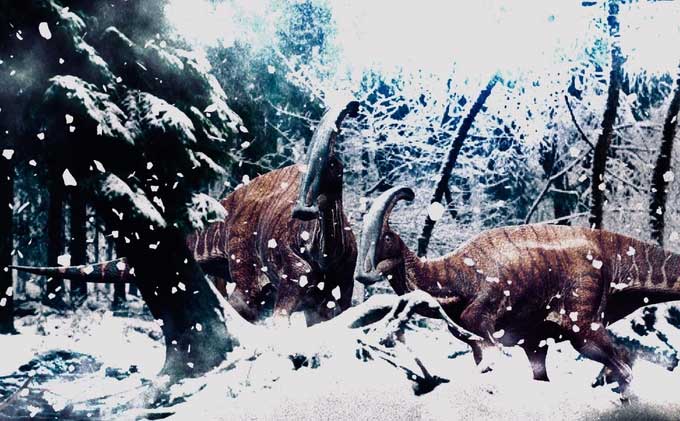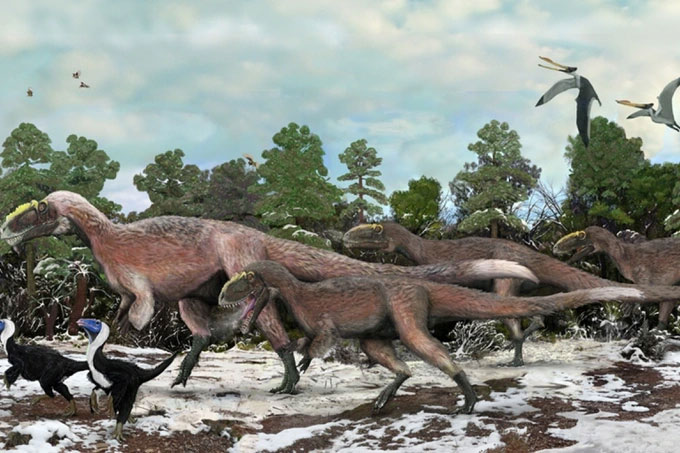Find out the secret of dinosaurs to rule all species
Dinosaurs first appeared in the southern temperate latitudes about 231 million years ago during the Triassic period (252 million - 201 million years ago). At that time, the continents on Earth were still linked together to form a supercontinent, called Pangea.

Dinosaur's ability to survive comes from cold tolerance.
Then, 202 million years ago, the Earth experienced an extinction event that marked the intersection between the Triassic and Jurassic periods, when a series of volcanic eruptions created a cloud of dust that obscured the sunlight. heaven, paving the way for a freezing cold that kills more than 75% of species living on land and in the ocean.
At that time, dinosaurs were forced to adapt to survive, research recently published in the journal Scientific Advances explains.
"The key to the absolute dominance of the dinosaurs was simple. They were basically cold-adapted animals. When it turned cold everywhere, they were basically ready, and the Other animals do not," Prof. Paul Olsen, lead author of the study, at Columbia University in New York, said.
To further support this claim, paleontologists have traced dinosaur footprints in a basin along the coast in China, which was once a frozen region. In addition, they also found small pebbles in the sediment, which is likely ice debris carried by the dinosaurs, and deposited when these layers melted in the summer.
This suggests that these areas were frequently frozen (at certain times of the year), and that dinosaurs were still potentially habitable.
According to study co-author Dennis Kent, this evidence suggests that dinosaurs not only survived the icy weather, but they thrived during it, and that's what made them great predators. absolute dominance over the Earth at the end of the Triassic.
How cold-resistant dinosaurs?

Certainly dinosaurs did well in cold climates, while many of their competitors died.
Dinosaurs' ability to withstand winter has long been questioned, because they did not possess the thick "fur" or cold-resistant fat like bears.
In fact, the new research has met with mixed views, and challenged the popular notion that dinosaurs were animals that could only survive in warm climates.
According to GS. Stephen Brusatte, an expert in paleontology and evolution at the University of Edinburgh, Scotland, these are just misconceptions about dinosaurs. "There used to be a stereotype that dinosaurs always lived in lush tropical forests, but new research shows that higher latitudes would have been frozen and even covered with ice at various points in the year. five," Brusatte said.
"It is not clear how they adapted to the cold, but the dinosaurs certainly did well in this climate, while many of their competitors died."
According to GS. Brusatte, this research also helps expand the search to the two poles, where dinosaurs may have once existed and lived. This will help scientists figure out how ancient reptiles used to survive in harsh environments.
- 10 weird, hard to imagine dinosaurs
- Earth prospect when dinosaurs existed to modern times
- Unfold the dinosaur secret
- Find the perfect fossil of ostrich-like dinosaurs
- The first dinosaurs appeared on Earth
- Find new dinosaurs that have crests like chickens
- Miniature dinosaurs into birds
- Dinosaurs heat the Earth?
- Discover the most 'weird' duckbill dinosaur in history
- Secrets of 'DNA' helps dinosaurs dominate Earth
- Discovered new carnivorous dinosaurs
- Dinosaurs' hard to chew because of the crisis
 Discovered an ancient centipede fossil 99 million years old
Discovered an ancient centipede fossil 99 million years old Discovered bat-like dinosaurs in China
Discovered bat-like dinosaurs in China Discovered a 200-year-old bronze cannon of the coast
Discovered a 200-year-old bronze cannon of the coast Discover 305 million-year-old spider fossils
Discover 305 million-year-old spider fossils